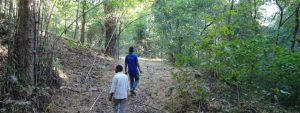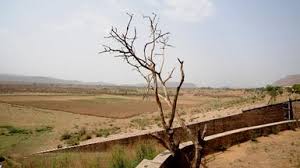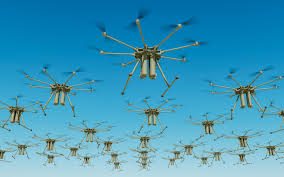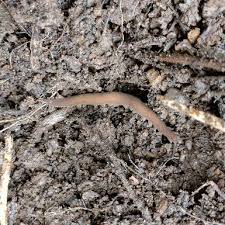Today’s Current Affairs: 12th April 2025 for UPSC IAS exams, State PSC exams, SSC CGL, State SSC, RRB, Railways, Banking Exam & IBPS, etc
Table of Contents
Microplastics:

A multinational study led by scientists from Nankai University, University of Massachusetts Amherst, and other institutions revealed that plant leaves can absorb microplastics and nanoplastics directly from the air.
- They are defined as plastic particles up to 5 millimetres in diameter, while nanoplastics are even smaller, measuring less than 1,000 nanometres.
- Primary microplastics (e.g., cosmetics, microfibers) and secondary microplastics (formed from the breakdown of larger plastics).
- Through product use, abrasion, or breakdown in natural settings.
- Microplastics are non-biodegradable, mobile, and accumulate in ecosystems.
- It can be ingested by marine and terrestrial organisms, causing toxicity and bioaccumulation.
- Microplastics can carry pollutants and toxic chemicals, further endangering ecological and human health.
- The study demonstrated that plastic particles entered leaves via multiple pathways, primarily through surface structures such as stomata and the cuticle.
- Stomata are tiny pores formed by specialised cells on leaves that regulate gas exchange.
- The cuticle is a wax-coated protective membrane on leaf surfaces that is particularly conducive to absorbing airborne particles like microplastics.
- Once inside, microplastics moved between plant cells and could accumulate in tiny, hair-like structures called trichomes on the surface of leaves.
- These particles were also found to travel through the plant’s water and nutrient transport systems, reaching other tissues, although trichomes acted as “sinks” by trapping many external particles and thereby limiting their movement to roots.
- The study highlights significant ecological and public health risks due to atmospheric plastic pollution, as micro- and nanoplastics bioaccumulate through the food chain.
- Despite these findings, the long-term impact on human health remains unclear, prompting a call for further investigation into:
- The extent of dietary exposure,
- The absorption efficiency of microplastics in the human digestive system,
- And the potential for plastic particles to reach internal organs.
Carbon Tax: India Vote

India, along with 62 other countries, voted in favour of the first global carbon tax on the shipping industry, adopted by the International Maritime Organisation (IMO) in London.
- A Carbon Tax is an environmental tax levied on the carbon content of fossil fuels such as coal, oil, and natural gas.
- The objective is to reduce greenhouse gas emissions by creating a financial disincentive for pollution and encouraging clean energy alternatives.
- It is calculated based on the amount of CO₂ or other GHGs emitted and promotes a market-based climate solution.
- Types of Carbon Tax
- Emissions tax: Tax on total GHG emissions, based on the carbon content of fuels used.
- Energy tax: Levied on fossil fuel consumption, calculated from carbon or energy usage.
- Cap-and-Trade System: Sets a cap on emissions; permits traded in a carbon market to incentivise reduction.
- Border tax adjustment: Applies carbon tax on imported goods based on emissions during production to prevent carbon leakage.
- India currently does not have a nationwide carbon tax, but there have been proposals to introduce one.
- In 2015, India proposed a carbon tax of INR 50 per metric ton on coal production/import, but it remains unimplemented.
- Some states, like Tamil Nadu, have introduced state-level carbon levies, particularly on coal used in electricity generation.
rt-LAMP Assay:

Researchers from Sree Chitra Tirunal Institute for Medical Sciences and Technology (SCTIMST), Thiruvananthapuram, have successfully developed a novel, indigenous, real-time LAMP (rt-LAMP) assay for the early detection of Tuberculosis (TB).
- The rt-LAMP assay is a molecular diagnostic tool similar to GeneXpert and Truenat, providing high sensitivity and specificity.
- It can detect TB DNA even when only 10 copies per microlitre are present, enabling early-stage diagnosis.
- Unlike RT-PCR, which requires three different temperature cycles, rt-LAMP works at a single temperature, simplifying the testing process.
- The test uses six primers for DNA amplification (compared to two in RT-PCR), ensuring faster and more specific detection.
- The researchers used a fluorescent dye (Syto 16)—commonly used in cell biology—which does not inhibit the reaction, solving the long-standing issue of false negatives in earlier LAMP tests.
- Results can be detected in 10–20 minutes, significantly reducing diagnostic time compared to RT-PCR.
- The rt-LAMP assay has been licensed to the industry for production.
- It has received approval from the Central Drugs Standard Control Organisation (CDSCO).
- The Indian Council of Medical Research (ICMR) is currently validating the technology.
- The World Health Organization’s Health Technology Access Pool (HTAP) also evaluates the test, pending ICMR validation.
Phawngpui National Park : Forest fires

Forest fires that had erupted in several parts of Mizoram’s Phawngpui National Park have affected nearly one-ninth of the park’s total area, state forest officials said recently.
- Phawngpui National Park, also known as the Blue Mountain National Park, is located in the southeastern corner of Mizoram, near the India-Myanmar border.
- It is the highest peak in the state, rising to an altitude of 2,157 meters above sea level.
- It overlooks the Chhimtuipui River and the hill ranges of Myanmar.
- The national park covers an area of 50 sq.km.
- The local Mizo people consider the national park as a sacred place, and believe that it is inhabited by the spirits of their ancestors.
- The national park is often enveloped by clouds, and appears blue from a distance.
- The thick forests are interspersed with small patches of grassy glades and are replete with diverse fauna typical of Montane Subtropical forests including oak, rhododendrons, and rare species of bamboos.
- It is home to an amazing variety of birdlife, including the rare Blyth’s Tragopan, Dark Rumped Swift, and Hume’s Pheasant, the Mizoram state bird, and endangered mammals like the Slow Loris, Tiger, Leopard, Leopard Cat, Serow, Goral, Asiatic Black Bear, Stump-tailed Macaque, and Capped Langur.
Saras Mk2:

The Saras Mk2, an updated version of an India-designed civilian aircraft, is set to test-fly in December 2027, Director, CSIR-National Aerospace Laboratories (CSIR-NAL) told recently.
- Saras Mk2 is a 19-seater, multi-purpose civilian aircraft.
- It is the first Indian multi-purpose civilian aircraft in the light transport aircraft category.
- It is being developed by National Aerospace Laboratories (NAL), Bengaluru, in collaboration with the Council of Scientific and Industrial Research (CSIR).
- It is an upgraded version of the Saras Mk 1.
- It can be used for multiple purposes, including for medical emergencies or in the event of natural disasters.
- It can also help in transporting passengers from Tier-1 cities to Tier-2 and Tier-3 cities.
- It will be a 7.5-ton aircraft and will have an endurance of 6 hours with a service ceiling of 29,000 ft.
- It will have a maximum range of 775 km with a max load of 19 passengers and 2450 km with 7 passengers.
- Its maximum cruise speed will be 500 kmph and stall speed 185 kmph.]The take-off distance for SARAS MK2 is going to be 790m, landing distance of 740m.
- The aircraft will be powered by 2 Pratt & Whitney Canada PT6A-67A turboprop engines.
Ramgarh Lake : Revival

Work has started for revival of the historic Ramgarh lake near Jaipur, which was once a lifeline for water supply to the Rajasthan Capital.
- It is situated near the Jamwa Ramgarh subdivision of the Jaipur district in the Indian state Rajasthan.
- It is a man-made water body created by forming an embankment on the forested hills.
- Erstwhile Jaipur ruler Sawai Ram Singh II had built the Ramgarh lake in 1876 to provide relief to the inhabitants of the region.
- It lies at a distance of 32 kilometres from Jaipur city and encompasses an area of about 15.5 sq.km.
- It measures 2 kilometres in width and 4 kilometres in length.
- Once, the lake served as the main source of water supply for the city of Jaipur.
- In the present time, the four rivers, Roda, Banganga, Tala, and Madhoveni, which used to bring water to the lake, have gone dry due to the deforestation and mining activity carried out in the catchment area.
- Ramgarh Lake has a historical record of hosting a rowing event during Asian Games of 1982.
- Jamwa Mata temple is situated at a downward course of Ramgarh Lake.
- The Polo Ground at Ramgarh, that sits in the middle of the Ramgarh Lake and the Aravalli Hills, is regarded as one of the best of its kind in the country.
- The thick forest near Ramgarh Lake is the abode to many wildlife species such as nilgai, chital, and lion.
- The region was notified as a wildlife sanctuary in the year 1982 by the Government of India.
Bullet Curtain:

China’s state-run defence firm Norinco recently said that it has developed the world’s first close-in anti-drone barrage weapon, dubbed the Bullet Curtain.
- It is the world’s first close-in anti-drone barrage weapon.
- It is capable of countering a broad range of low-flying aerial threats including rockets, helicopters, missiles, and most notably, drone swarms.
- It has been made by China’s state-run defence firm Norinco.
- The system was inspired by Metal Storm, which is a rapid-fire weapon concept jointly developed by Australia and the United States in the late 1990s.
- Conventional anti-air systems typically rely on “point-to-point” interception, aiming directly at incoming threats.
- By allowing multiple guns to fire together, the Bullet Curtain system creates a plane of fire that increases the probability of intercepting fast, unpredictable targets.
- The system uses a “plane-to-point” interception model, which forms a wall of projectiles to blanket incoming targets with overlapping firepower.
- The system reportedly uses a 4×4 tight arrangement of 35mm gun barrels for various types of ammunition to deliver a high rate of fire while maintaining quick reload capabilities.
- It fires 35mm advanced hit efficiency and destruction (AHEAD) ammunition that spits hundreds of sub-projectiles each to form a barrage against drones.
- The system reportedly integrates radar, an optical detection system, a fire-control system, an integrated management system, and ammunition with the platform.
- The system has been fitted on a 6×6 truck and configured as a road-mobile air-defence cover embedded in mechanised units.
- Its modular design means it can also be integrated with various platforms, including wheeled and tracked armoured vehicles, naval ships, and fixed installations, allowing rapid deployment across different combat scenarios while staying compatible with existing military infrastructure.
- A computer-based system adjusts the volume and type of fire depending on the target’s nature, allowing dynamic threat engagement.
Typhloperipatus williamsoni:

A team of researchers recently reported rediscovering a long-lost species of the velvet worm, named Typhloperipatus williamsoni, one of the oldest living fossils in the world, after 111 years.
- It is an ancient velvet worm species (phylum Onychophora), one of the oldest living fossils in the world.
- Onychophora is a very old group, easily older than 350 million years.
- It has only two families and not more than 200 species. The diversity is very less.
- These were evolving almost simultaneously with dinosaurs. When the mass extinction happened, probably a lot of them were wiped out.
- T. williamsoni was rediscovered after 111 years from the Siang Valley in Arunachal Pradesh.
- T. williamsoni was first collected during the “Abor expedition” by Stanley Kemp, the erstwhile superintendent of the Indian Museum, Calcutta, and his team in December 1911 in Siang Valley.
- Since Kemp’s discovery, there have been no documented records of it from India.
Kathak dancer Kumudini Lakhia passed away:
Renowned Kathak dancer Kumudini Lakhia passed away recently at the age of 94.The term Kathak is derived from the Sanskrit word ‘Katha’, meaning ‘story’. Kumudini Lakhia challenged the classical notion that Kathak must always revolve around storytelling based on mythological or literary themes like Radha-Krishna or Shiva-Parvati.She believed in “art for art’s sake”, focusing on movement, rhythm, and form over narrative content.It originated as a temple performance where stories from scriptures were enacted and evolved into a court dance during the Mughal period.
Virat Kohli becomes First Player to Score 1000 Fours and Sixes in IPL:
Virat Kohli, the talismanic Royal Challengers Bengaluru batter, continues to redefine cricketing greatness in the Indian Premier League (IPL). In the 2025 season, he etched his name into the record books by becoming the first player ever to register a combined total of 1000 fours and sixes in IPL history. This historic milestone was achieved during the match between RCB and Delhi Capitals at the M Chinnaswamy Stadium, Bengaluru. Though Kohli’s personal achievement stood out, RCB couldn’t avoid a defeat at home, falling short against a dominant DC side led by KL Rahul and Tristan Stubbs.
Industrial Production Slows to 6-Month Low of 2.9% in February 2025:
India’s industrial activity witnessed a marked deceleration in February 2025, with the Index of Industrial Production (IIP) expanding at just 2.9%, the slowest pace in six months. The sharp drop was largely attributed to sluggish growth across key sectors—mining, manufacturing, and electricity and the high base effect from the previous year. While most use-based categories registered reduced output, capital goods emerged as the only bright spot with a notable uptick in production.
Kavach 5.0 To Boost Mumbai Local Train Services by 30%:
Union Railway Minister Ashwini Vaishnaw announced the implementation of Kavach 5.0, the next-generation Automatic Train Protection (ATP) system. This advancement aims to increase the frequency of trains by 30%, providing relief to nearly 80 lakh daily commuters. Kavach not only enhances train safety during inclement weather but also supports loco pilots by automatically applying brakes if they fail to act in time, ensuring smoother and safer railway operations.
Padma Shri Awardee Daripalli Ramaiah (“Vanajeevi”) Dies at 87 in Telangana:
Daripalli Ramaiah, a prominent environmentalist known as “Vanajeevi” or “Chettu Ramaiah,” passed away at the age of 87 in Khammam district, Telangana. He died of a heart attack at his home in Reddipalli village. Ramaiah was widely recognized for planting over one crore saplings across the district over several decades, earning him national acclaim as a green crusader. He was honored with the Padma Shri Award in 2017 for his contribution to environmental conservation.
Madhya Pradesh Declares New Wildlife Sanctuary Named After Dr. B.R. Ambedkar:
The Madhya Pradesh government has declared a new wildlife sanctuary in Sagar district, covering an area of 258.64 square kilometers. The sanctuary, named Dr. Bhimrao Ambedkar Abhyaran, was officially announced ahead of the 134th birth anniversary of Dr. B.R. Ambedkar, which will be observed on April 14. This new sanctuary aims to enhance wildlife conservation efforts, promote eco-tourism, and generate employment opportunities for local communities.
Dr. Ambrish Mithal Conferred with the Prestigious IOF 2025 CSA Medal of Achievement:
Dr. Ambrish Mithal, a renowned Indian endocrinologist, has been honored with the 2025 Committee of Scientific Advisors (CSA) Medal of Achievement by the International Osteoporosis Foundation (IOF) for his exceptional contributions to osteoporosis research. The award was presented to Dr. Mithal at the World Congress on Osteoporosis, Osteoarthritis & Musculoskeletal Diseases (WCO-IOF-ESCEO 2025) held in Rome, Italy. Dr. Mithal’s pioneering work in the field of endocrinology and osteoporosis has greatly advanced the understanding and treatment of the disease, particularly in India.
James Anderson Awarded Knighthood Honour:
James Anderson, England’s legendary fast bowler, has been awarded a knighthood in the resignation honours list of former Prime Minister Rishi Sunak, announced on April 11, 2025. Known for his remarkable longevity and record-breaking performances, Anderson retired from international cricket in 2024, leaving an unmatched legacy in Test bowling
Jallianwala Bagh Massacre 1919 A Tragic Event in Indian History:
The Jallianwala Bagh Massacre of 1919 is one of the most pivotal and tragic events in the history of India’s struggle for independence. On April 13, 1919, British troops under the command of General Reginald Dyer opened fire on an unarmed crowd of Indian civilians, leading to the deaths of hundreds. This brutal act of violence marked a turning point in India’s freedom movement, as it galvanized widespread national resistance against British colonial rule. The massacre not only exposed the harsh realities of British oppression but also instilled a renewed sense of urgency and unity among the Indian population to seek independence.




